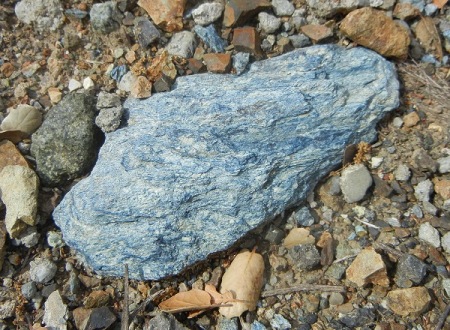It may seem like I have a fixation on blueschist. I’ll admit that. I have a fixation on every rock type. Here’s a fine blueschist boulder at the very north end of Castle Drive, in the Piedmont Pines neighborhood.
This qualifies as a knocker, and it also qualifies as a high-grade block. “Knocker” is local geologists’ slang for a small block of resistant rock that protrudes out of an area of melange (like those in Mountain View Cemetery that I feature here in the “cemetery knockers” category). By default that’s understood to mean Franciscan melange, because melange—a collection of geological bric-a-brac mixed in a matrix of shale—practically defines the Franciscan complex. However this high-grade block is in the serpentinite patch, part of the Coast Range ophiolite, which also qualifies as melange.
Oakland’s serpentine patch contains a goodly share of blueschist. This is a piece of it near Redwood Road that was lying right next to a piece of classic serpentinite.
The key indicator for me is the color, which is typical of the mineral glaucophane. Glaucophane is described as various shades of blue, while serpentine is described as varous shades of green. They differ in their luster and hardness as well. My gold standard is the classic occurrence at Ward Creek near Cazadero, which I visited in 2005. Here are two photos from there.
So glaucophane tends to a dusky, blue-jean blue or gray-blue. Green minerals like chlorite, epidote and omphacite may accompany it as they do here.
Technically, blueschist is a metamorphic facies rather than a specific rock type—it’s a set of typical minerals that form at a specific combination of heat and pressure. Glaucophane and lawsonite indicate the blueschist facies in metamorphosed rocks of mafic (MAY-fic) composition, like basalt. In metasedimentary rocks, the indicator minerals are phengite, chlorite and quartz. Those won’t make a blue rock (they’ll be greenish). So amateurs like you and me shouldn’t read “blueschist” and envision something blue. But in Oakland, we do have real blue blueschist. (Some of the Franciscan sandstone also has blueschist-level minerals in it.)
Serpentinite doesn’t change much with pressure. It’s a cryptic rock that doesn’t retain many traces of its history. But the blueschist that accompanies it in the Oakland serpentine patch testifies to fast, deep burial and equally rapid exhumation.




26 April 2021 at 11:20 am
I’ve got a bucket full that I saved taking apart a stacked stone deck foundation in Kensington – https://standoutwork.blogspot.com
21 April 2023 at 9:13 am
For others also fascinated by blueschist: if you are north Berkeley, check out 661 San Luis Road. Fantastic blue schist knocker. Quite visible in google street view.